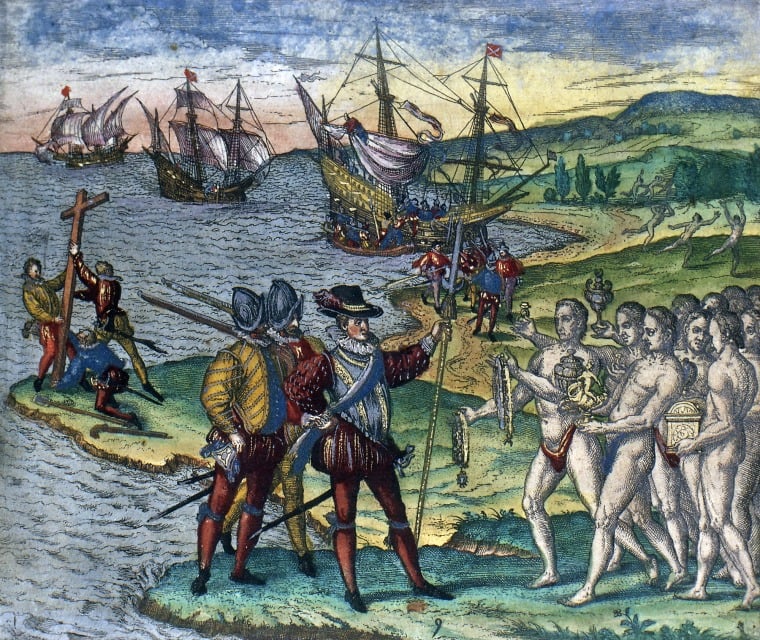Columbus and the Taíno

When Christopher Columbus set sail from Spain in 1492, he was locked into a geographical view of the world which did not anticipate a continent between Europe and Asia. He had set sail for India-a 15th century concept which referred to southern China and southeastern Asia-so when he landed on some islands he assumed that he was off the coast of Asia. On behalf of the Catholic Monarchs of Spain, he claimed the land and the people for Spain, conveniently ignoring native government and native ownership of the land.
The population of the Americas in 1492 is estimated to be 100 million, as compared with 70 million in Europe.
Europeans were not known for their religious tolerance. The day before Columbus left Spain, all of the Jews in Spain were required to leave. During the time that Columbus was preparing for his voyage, an estimated 30,000 Spanish Jews were burned at the stake for their failure to convert to Catholicism.
The Taíno were the first Native Americans to encounter the Spanish. Columbus recorded in his diary that the natives “would easily be made Christians because it seemed to me that they had no religion.”
After Columbus had returned to Europe and word of his discoveries reached the royal courts of Portugal and Spain, there were heated debates over the ownership of the new lands. Pope Alexander VI stepped in to solve the dilemma. Papal bulls by Pope Alexander VI granted Spain and Portugal all of the lands in the Americas which were not under Christian rule. Thus began the European assumption that the native people of the area did not really own the land because they were not Christian. The Pope decreed that
“barbarous nations be overthrown and brought to the faith itself.”
The Inter Caetera papal bull by Pope Alexander VI stated:
“We trust in Him from whom empires, and governments, and all good things proceed.”
This laid the legal foundation for assuming that government comes only from the Christian god and therefore Christian nations have a legal right to rule over non-Christian nations. The late Vine Deloria in his “Afterword,” for America in 1492: The World of Indian Peoples Before the Arrival of Columbus wrote:
“Thus armed with a totally bogus title issued by God’s representative on earth, the Spaniards then began a brutal conquest in the Americas which virtually obliterated the native populations in the Caribbean within a generation.”
The discovery of Indians presented some problems for Europeans since they were not mentioned in the Christian Bible: the Native Americans did not fit within orthodox Christianity’s explanation of the moral universe.
At the time of first contact with the Spanish, the Taíno world stretched across the Caribbean Islands for more than a thousand miles. The Taíno, part of the Arawak language group, had arrived on the islands more than 2,000 years earlier from South America. By 700 CE, they occupied the Lesser Antilles and Puerto Rico. They then pushed into the Greater Antilles-Hispaniola, Jamaica, and Cuba.
In South America, the Arawak-speaking ancestors of the Taíno had a lifestyle that centered around the growing of manioc and other root crops, hunting, fishing, and gathering wild plants. This lifestyle adapted to the islands and the sea, rather than separating them, seemed to unite them. They had ocean-going canoes which could hold as many as a hundred people. Voyages between the islands were common place. Intermarriage among the lineages of the different islands was also common and helped build a unifying network of kinship relations.
Another unifying element among the Taíno was the ball game. The game, which was also found in Mesoamerica and part of South America, was played using a rubber ball on courts with stone or earthen embankments. As in Mesoamerica, the ball was struck primarily with the hips. For the Taíno, the game was the focus of religious festivals, feasting, trade, intermarriage, and the peaceful resolution of conflicts.
The political power of Taíno leaders stemmed from: (1) the mother’s lineage (very different from that of European monarchs), (2) having a special relationship with the supernatural, and (3) political acumen. A “chief” (this is a European leadership term) could be deposed by his brothers or nephews.
When Columbus landed on the island of Hispaniola, Guarionex was one of the five most powerful Taíno leaders with followers numbered in the tens of thousands scattered over hundreds of square miles.
By 1495, the Spanish who had originally been welcomed by the Taíno, had managed to alienate their hosts. Guarionex and the other Taíno leaders decided that they had had enough and tens of thousands of Taíno warriors (some reports claim a hundred thousand) gathered to do battle with 200 Spaniards. The battle was unlike anything that the Taíno had ever experienced. It began with twenty Spanish warriors, fully armored and riding warhorses through their ranks inflicting great damage with their swords and lances. Then foot soldiers fired their guns, a terrifying weapon to those who had never encountered it. Finally, the Spanish set loose their large dogs, trained to kill humans, upon the Taíno warriors. The Spanish goal seemed to be to kill as many Taíno as possible, a goal that was unheard of in the traditional warfare on the islands.
Following their defeat, the Taíno accepted their status as Spanish subjects. They agreed to pay tribute in the form of food, cotton, and gold. The Spanish demanded that every man over the age of 14 provide them with a little copper bell filled with gold every three months. Providing gold, however, was not the greatest hardship on the Taíno: the Spanish were eating them out of house and home. Not only did the Spanish seem to eat far more than the Taíno, but they also ate the manioc that wasn’t ready to be harvested. The result was food shortages and starvation for the Taíno.
Columbus viewed the Taíno themselves as a way to amass his personal wealth. He selected 500 to be exported to Spain as slaves, and 500 to serve as slaves to the Spanish on the Island. Columbus proudly boasted to the Spanish monarchs about the slave potential and its economic benefits. Columbus would capture and export more Indian slaves-about 5,000 — than any other single individual. In addition to capturing the Indians as slaves, the Spanish also hunted the Indians for sport and slaughtered them for dog food. The Spanish also viewed Taíno women as their sex slaves.
By 1497, the combination of starvation, European diseases, and Spanish brutality had reduced the Taíno numbers. Christopher Columbus was neither a good leader, nor particularly charismatic. Many of his men hated him. As a result, the Spaniard Francisco de Roldán led a small army of anti-Columbus soldiers. He encouraged the Taíno leaders, including Guarionex, to join with them in defeating the other Spanish.
Don Bartolomé Colón, the brother of Columbus, was a better leader and had, in fact, learned to speak some Taíno. Bartolomé moved against the incipient rebellion by staging a midnight raid on the Taíno villages, a serious breach of Taíno war etiquette, and capturing as many Taíno leaders as possible. They killed the leaders in the traditional Spanish style: they burned them alive.
Traditionally, Taíno leaders not only directed their warriors in battle, but more importantly they mediated with the spirit helpers to ensure victory. Without their leaders, the Taíno warriors were in chaos and soon surrendered.
The destruction of the Taíno political system, coupled with the demands for tribute and the devastating impact of disease and starvation, led to the virtual extinction of Taíno society on Hispaniola by 1500.
While there are some historians and pseudo-historians who point to Christopher Columbus as an example of perseverance, courage, and Christian faith, there are others who feel that his legacy, from a Native American viewpoint, is one of genocide and slavery.

